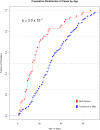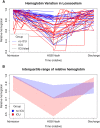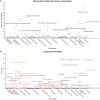Defining the complex phenotype of severe systemic loxoscelism using a large electronic health record cohort
- PMID: 28422977
- PMCID: PMC5396866
- DOI: 10.1371/journal.pone.0174941
Defining the complex phenotype of severe systemic loxoscelism using a large electronic health record cohort
Abstract
Objective: Systemic loxoscelism is a rare illness resulting from the bite of the recluse spider and, in its most severe form, can lead to widespread hemolysis, coagulopathy, and death. We aim to describe the clinical features and outcomes of the largest known cohort of individuals with moderate to severe loxoscelism.
Methods: We performed a retrospective, cross sectional study from January 1, 1995, to December 31, 2015, at a tertiary-care academic medical center, to determine individuals with clinical records consistent with moderate to severe loxoscelism. Age-, sex-, and race-matched controls were compared. Demographics, clinical characteristics, laboratory measures, and outcomes of individuals with loxoscelism are described. Case and control groups were compared with descriptive statistics and phenome-wide association study (PheWAS).
Results: During the time period, 57 individuals were identified as having moderate to severe loxoscelism. Of these, only 33% had an antecedent spider bite documented. Median age of individuals diagnosed with moderate to severe loxoscelism was 14 years old (IQR 9.0-24.0 years). PheWAS confirmed associations of systemic loxoscelism with 29 other phenotypes, e.g., rash, hemolytic anemia, and sepsis. Hemoglobin level dropped an average of 3.1 g/dL over an average of 2.0 days (IQR 2.0-6.0). Lactate dehydrogenase and total bilirubin levels were on average over two times their upper limit of normal values. Eighteen individuals of 32 tested had a positive direct antiglobulin (Coombs') test. Mortality was 3.5% (2/57 individuals).
Conclusion: Systemic loxoscelism is a rare but devastating process with only a minority of patients recalling the toxic exposure; hemolysis reaches a peak at 2 days after admission, with some cases taking more than a week before recovery. In endemic areas, suspicion for systemic loxoscelism should be high in individuals, especially children and younger adults, presenting with a cutaneous ulcer and hemolysis or coagulopathy, even in the absence of a bite exposure history.
Conflict of interest statement
Figures



Similar articles
-
Coagulation abnormalities following brown recluse spider (Loxosceles reclusa) envenomation: A description of 2 cases and review of the literature.Am J Clin Pathol. 2025 Jun 3;163(6):822-836. doi: 10.1093/ajcp/aqaf001. Am J Clin Pathol. 2025. PMID: 39883062 Free PMC article. Review.
-
Cutaneous-hemolytic loxoscelism following brown recluse spider envenomation: new understandings.Clin Toxicol (Phila). 2020 Dec;58(12):1297-1305. doi: 10.1080/15563650.2020.1739701. Epub 2020 Mar 18. Clin Toxicol (Phila). 2020. PMID: 32186919
-
Brown recluse spider envenomation with systemic loxoscelism and delayed hemolysis: A case report.Toxicon. 2023 Jan 15;222:106975. doi: 10.1016/j.toxicon.2022.106975. Epub 2022 Nov 21. Toxicon. 2023. PMID: 36410457
-
First record of a case of cutaneous loxoscelism caused by violin spider (Loxosceles yucatana) bite in Yucatan, Mexico.Rev Peru Med Exp Salud Publica. 2022 Oct-Dec;39(4):489-494. doi: 10.17843/rpmesp.2022.394.11047. Epub 2023 Mar 6. Rev Peru Med Exp Salud Publica. 2022. PMID: 36888813 Free PMC article.
-
Coombs-positive hemolytic anemia secondary to brown recluse spider bite: a review of the literature and discussion of treatment.Cutis. 2004 Dec;74(6):341-7. Cutis. 2004. PMID: 15663070 Review.
Cited by
-
Genome-wide and Phenome-wide Approaches to Understand Variable Drug Actions in Electronic Health Records.Clin Transl Sci. 2018 Mar;11(2):112-122. doi: 10.1111/cts.12522. Epub 2017 Nov 17. Clin Transl Sci. 2018. PMID: 29148204 Free PMC article. Review. No abstract available.
-
Coagulation abnormalities following brown recluse spider (Loxosceles reclusa) envenomation: A description of 2 cases and review of the literature.Am J Clin Pathol. 2025 Jun 3;163(6):822-836. doi: 10.1093/ajcp/aqaf001. Am J Clin Pathol. 2025. PMID: 39883062 Free PMC article. Review.
-
Systemic Loxoscelism, Less Frequent but More Deadly: The Involvement of Phospholipases D in the Pathophysiology of Envenomation.Toxins (Basel). 2022 Dec 27;15(1):17. doi: 10.3390/toxins15010017. Toxins (Basel). 2022. PMID: 36668837 Free PMC article. Review.
-
Diethyl Azelate for the Treatment of Brown Recluse Spider Bite, a Neglected Orphan Indication.In Vivo. 2022 Jan-Feb;36(1):86-93. doi: 10.21873/invivo.12679. In Vivo. 2022. PMID: 34972703 Free PMC article.
-
Toxin-Mediated Myocarditis From a Brown Recluse Spider Bite.JACC Case Rep. 2021 Oct 31;4(1):49-53. doi: 10.1016/j.jaccas.2021.10.003. eCollection 2022 Jan 5. JACC Case Rep. 2021. PMID: 35036944 Free PMC article.
References
-
- Sams HH, Dunnick CA, Smith ML, King LE Jr., Necrotic arachnidism. J Am Acad Dermatol. 2001;44(4):561–73; quiz 73–6. Epub 2001/03/22. doi: 10.1067/mjd.2001.112385 - DOI - PubMed
-
- Futrell JM. Loxoscelism. Am J Med Sci. 1992;304(4):261–7. Epub 1992/10/01. - PubMed
-
- Murray LM, Seger DL. Hemolytic anemia following a presumptive brown recluse spider bite. J Toxicol Clin Toxicol. 1994;32(4):451–6. Epub 1994/01/01. - PubMed
-
- Rosen JL, Dumitru JK, Langley EW, Meade Olivier CA. Emergency department death from systemic loxoscelism. Ann Emerg Med. 2012;60(4):439–41. Epub 2012/02/07. doi: 10.1016/j.annemergmed.2011.12.011 - DOI - PubMed
-
- Nance WE. Hemolytic anemia of necrotic arachnidism. Am J Med. 1961;31:801–7. Epub 1961/11/01. - PubMed
MeSH terms
Substances
Grants and funding
LinkOut - more resources
Full Text Sources
Other Literature Sources
Medical

